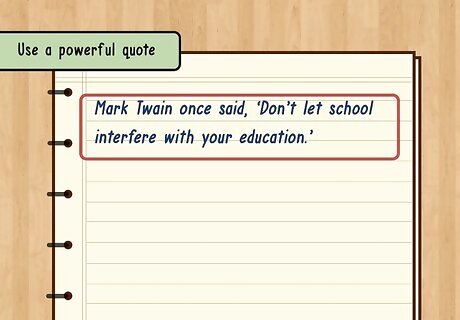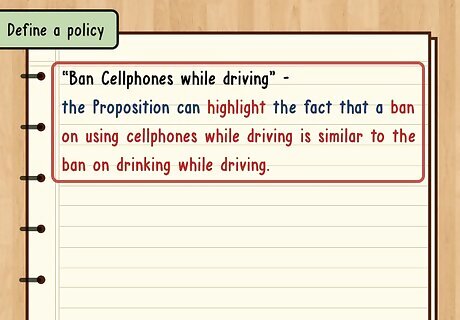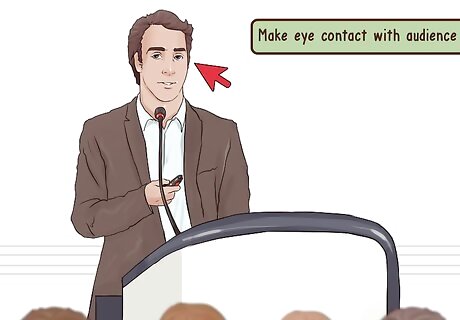
views
Grabbing the Audience's Attention

Tell a captivating story. This can be a personal anecdote about why you are passionate about the topic, an anecdote about another person who the audience can learn from, a wisdom tale, fable, or a historic event or anecdote that captures the key points of your argument. Your story should capture the essence of your debate. It could explore, for example, the challenges you have faced in relation to the topic, how you overcame these challenges, and the lessons you learned. For example, "As a person who suffers from seizures, medical marijuana was a saving grace. My family and I had to move across to the country in order for me to get treated, but it was worth the risk. My seizures decreased from five seizures a day to only one seizure per week." Make sure that the story comes from your heart rather than your head. If you're just regurgitating a story from memory, it's not going to land with the audience.

Ask a rhetorical question. When rhetorical questions are crafted and delivered well, they can persuade an audience to side with your position. You want the audience to answer the question for themselves silently, while directing attention to your topic. Ask a question that convinces your audience that you are similar to them and that your share their beliefs. You can ask, for example, “Would you like to see a loved one suffer for no reason at all?”

State a shocking statistic. Your statistic should be directly related to your argument's main purpose. The impact of the statistic can persuade your audience to side with your way of addressing the issue at hand. You can say, for example, “A billion tons of plastic are floating in the ocean right now. That is enough plastic to make an island the size of Hawaii.” Then, proceed to talk about the issue and explain to your audience why your resolution is the best one.

Use a powerful quote. Using quotes in a speech reinforces and adds credibility to your ideas. Quotes also demonstrate that you are knowledgeable about the topic. Your quote should be related to the topic, and relevant to the audience. Also, try to quote well-known people, or people your audience knows. For example, imagine you are giving a speech on why you think higher education is unnecessary for succeeding in life. You could open with, “Mark Twain once said, ‘Don’t let school interfere with your education.’” Make sure that quote comes from your heart and feels authentic. It must speak to you and your audience while also making a point.

Use a prop or a creative visual aid. For example, a picture, video, or an object that captures the essence of your argument. A creative visual aid increases comprehension of the issue, adds aesthetic appeal, and engages your audience's imagination. It will also make the message more memorable. For example, if you are arguing that climate change is real, show a before and after picture of a glacier that has been affected by excessive amounts of carbon dioxide in the atmosphere.
Beginning the Debate

Establish definitions. The key terms in the debate need to be explained and defined by the first speaker. Also, define key terms that the audience might not know very well. Identify the key terms in your argument and look up their definitions in a range of dictionaries. Choose the most appropriate definition for each word. You want to pick a definition that is neutral and conventional. Your definitions can be literal, as well as contextualized. Contextualized definitions add examples of how the concept applies to the real world. For example, a contextualized definition of money would show that money is used to buy services, such as food and gas.

Summarize your position’s case. After defining the key terms, you need to tell the audience what you and your group will be arguing and why. Reinforce your arguments by reiterating your position in various ways. For example, “My team and I will show you the need, practicality, and benefits of medicinal marijuana. Together we will show that thousands of patients, including young children, who suffer from seizures, find relief in medicinal marijuana. Studies show that medicinal marijuana reduces instances of seizures by 80%. Furthermore, the side effects of medicinal marijuana are not as severe as the side effects that come with conventional forms of medication used to treat seizures, particularly for children. We will show that medicinal marijuana is a practical, safe, and cost-effective solution for patients and their families.”

Define a policy. Your team's argument should include a proposition on how to address the problem you are debating about. Debating teams do this by defining a policy they wish to enact. The first speaker should outline the core component of the policy, as opposed to a detailed explanation of it. In order to demonstrate that your team's policy will work, use policies that have already been enacted as the basis of your policy. For example, you can highlight that a ban on using cellphones while driving is similar to the ban on drinking while driving. Try to focus on three important reasons for why the policy is needed or needs to change.
Presenting the Debate

Greet the audience. You should always greet your audience. Greeting your audience shows that you are confident and serious about the topic you will be debating about. It also shows that you respect your audience's opinion. Greet your audience by saying, “Good morning faculty and staff. The topic of today’s debate is student parking,” or “Good morning teachers and students. Thank you for taking the time to come to this debate. Today, the topic is student parking.”

State what your side is arguing. After you greet your audience, concisely state your team's argument. The audience can become distracted or lose interest if your statement contains too many words. Also, explain to your audience the speakers' roles. State what your side is arguing by saying, “We believe enrolled students should not have to pay for a parking pass to park on campus,” or “We believe enrolled students should pay for a parking pass to park on campus.” Explain the speakers' roles by saying, “As the first speaker, I will be defining key terms and outlining our main argument. Our second speaker will explain the supporting reasons for our argument, and our third speaker will summarize our argument.”

Make eye contact with audience members. Try to make eye contact with individual persons in the audience. By making eye contact, you can gauge their reactions by reading their facial expressions. Also, you will be able to connect with audience members on a more personal level, and thus, make your argument more persuasive. Remember to maintain eye contact with an audience at the end of a sentence. Hold eye contact with an individual for only three to five seconds, then move on to someone else. Practice holding eye contact with someone you know for a minute or two. Repeat the exercise 5 or 6 times—that will really help a lot.

Speak slowly and clearly. Slow down your speaking by remembering to breathe while you speak. After you finish a sentence, take a deep breath, and then move on to the next sentence. Also, remember to take pauses. Pauses allow you to catch your breath and plan what you will say next. They also allow your audience to process what you have just said.
















Comments
0 comment